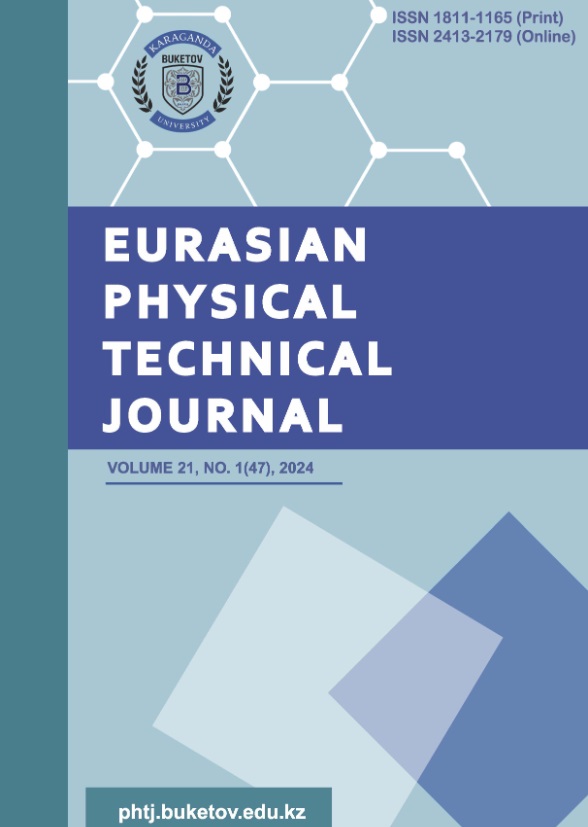Жаңа металл / асқын өткізгіш-диэлектрлік ауысулары және олардың легирленбеген және оңтайлы легирленген купраттардағы жоғары температуралы асқын өткізгіштікке әсері
DOI:
https://doi.org/10.31489/2024No1/21-27Кілт сөздер:
полярондардың және заряд тығыздығы толқындарының түзілуі, металл / асқын өткізгіш-диэлектрлік ауысу, купраттар, Бозе-сұйықтық асқын өткізгіштік, әртүрлі бұзылулар, жоғары температуралы асқын өткізгіштікті әлсірету және күшейтуАңдатпа
Металл/асқын өткізгіш-диэлектрик полярондардың түзілуін және олардағы легирленген заряд тасымалдаушылардың (тесіктердің) локализациясын және металл немесе асқын өткізгіш жүйені диэлектрикке айналдыру мүмкіндігін зерттеу арқылы легирленген купраттарда ауысуының жаңа әдіс-тәсіл әзірленді. Мұндай фазалық ауысудың неғұрлым қолайлы критерийі үлкен полярондардың жолақ енін (немесе Ферми энергиясын) олардың купраттардағы байланыс энергияларымен салыстыру арқылы алынды. Легирленген купраттардағы металл/асқын өткізгіш - диэлектрлік ауысу және фазалық ыдырау мүмкіндігі болжанған, нәтижесінде легирленбеген, оңтайлы легирленген және тіпті аса легирленген жоғары температуралы купраттарда бәсекелес металл/асқын өткізгіш және диэлектрлік фазалар пайда болады. Содан кейін әртүрлі бұзылулардың (мысалы, полярондардың түзілуі және заряд тығыздығының толқындық ауысуы) және қатар болатын диэлектрлік және асқын өткізгіш фазалардың легирленбеген және оңтайлы легирленген купраттардың асқын өткізгіштік ауысуының TC критикалық температурасына ықтимал зиянды және пайдалы әсері зерттелді. Бұл материалдардағы асқын өткізгіштік ауысуының TC нақты температурасы жоғары температуралы купраттардағы сәйкес TC мәнін болжай алмайтын Бардин-Купер-Шриффер типті Ферми-сұйықтық асқын өткізгіштік теориясын емес, Бозе-сұйықтықтың асқын өткізгіштік теориясын қолдана отырып анықталды. Оңтайлы легирленген купраттардағы полярондық және заряд тығыздығы толқынының әсерлерін кемуі Tc –ның жоғарылауына әкелетінін және купраттардағы кейбір тор ақаулары (мысалы, аниондық бос орындар) Tc-ға қатты әсер етіп, олардағы жоғары температуралық асқын өткізгіштікті күшейтетінін анықталды.
References
Imada M., Fujimori A., Tokura Y. Metal-insulator transitions. Review of Modern Physics, 1998, Vol.70, pp.1039. https://doi.org/10.1103/RevModPhys.70.1039
Dzhumanov S. Theory of Conventional and Unconventional Superconductivity in the High-T Cuprates and Other Systems. Nova science publishers, New York, USA, 2013, 356 p. https://novapublishers.com/shop/theory-of- conventional-and-unconventional-superconductivity-in-the-high-tc-cuprates-and-other-systems/
Dzhumanov S., Baimatov P.J., Ganiev O.K., Khudayberdiev Z.S., Turimov B.V. Possible mechanisms of carrier localization, metal–insulator transitions and stripe formation in inhomogeneous hole-doped cuprates. Journal of Physics and Chemistry of Solids, 2012, Vol.73(3), pp. 484 – 494. https://doi.org/10.1016/j.jpcs.2011.11.029
Lee P.A., Nagaosa N., Wen X.-G. Doping a Mott insulator: Physics of high-temperature superconductivity. Review of Modern Physics, 2006, Vol.78 (1), pp. 17 – 85. https://doi.org/10.1103/RevModPhys.78.17
Bardeen J., Cooper L.N., Schrieffer J.R. Theory of superconductivity. Physical Review, 1957, Vol.108 (5), pp.1175. https://doi.org/10.1103/PhysRev.108.1175
Lavrov A.N., Gandmakher V.F. Low-temperature resistivity of underdoped cuprates, Physics-Uspekhi, 1998, Vol.41(2), pp. 223-226. https://ufn.ru/ufn98/ufn98_2/ufn982ai.pdf
Goldman A.M., Markovic N. Superconductor‐Insulator Transitions in the Two‐Dimensional Limit. Physics Today, 1998, Vol.51(11), pp. 39 - 44. https://doi.org/10.1063/1.882069
Vedeneev S.I. High-temperature superconductors in high and ultrahigh magnetic fields. Physics-Uspekhi, 2012, Vol.55(6), pp. 625 – 632. https://doi.org/10.3367/UFNe.0182.201206h.0669
Ino A., Kim C., Nakamura M., Yoshida T., Mizokawa T., Shen Z.-X., Fujimori A., Kakeshita T., Eisaki H., Uchida S. Electronic structure of La2-xSrxCuO4 in the vicinity of the superconductor-insulator transition. Physical Review B, 2000, Vol.62, pp. 4137. https://doi.org/10.1103/PhysRevB.62.4137
Ono S., Ando Yoichi, Murayama T., Balakirev F.F., Betts J.B., Boebinger G.S. Metal-to-Insulator Crossover in the Low-Temperature Normal State of Bi2Sr2−xLaxCuO6+δ. Physical Review Letters, 2000, Vol. 85(3), pp. 638 – 641. https://doi.org/10.1103/PhysRevLett.85.638
Anshukova A.I., Golovashkin L.I., Ivanova A.P., Rusakov. J. The effect of superstructural ordering on the properties of high-temperature oxide superconductor systems. Journal of Experimental and Theoretical Physics, 2003, Vol.96(6), pp. 1045. https://doi.org/10.1134/1.1591216
Abrikosov A.A. Resonant tunneling in high-Tc superconductors. Physics-Uspekhi, 1998, Vol.41(6), pp. 605 - 616. https://doi.org/10.1070/PU1998v041n06ABEH000411
Kastner M.A., Birgeneau R.J., Shirane G., Endoh Y. Magnetic, transport, and optical properties of monolayer copper oxides. Review of Modern Physics, 1998, Vol.70(3), pp. 897 – 928. https://doi.org/10.1103/RevModPhys.70.897
Basov D.N., Timusk T. Electrodynamics of high-Tc superconductors. Review of Modern Physics, 2005, Vol.77(2), pp. 721 – 779. https://doi.org/10.1103/RevModPhys.77.721
Dzhumanov, S., Khidirov, I., Kurbanov, U. T., Khudayberdiev, Z. S., Rashidov, J. S. Distinctive Features of Metal-Insulator Transitions, Multiscale Phase Separation, and Related Effects in Hole-Doped Cuprates. Ukrainian Journal of Physics, 2019, Vol. 64(4), pp. 322. https://doi.org/10.15407/ujpe64.4.322
Dzhumanov S., Sabirov S.S., Karimbaev E.X., Rashidov J.Sh., Djumanov D.S., Kurbanov U.T., Sheraliev M.U. Formation of strong-coupling (bi)polarons and related in-gap states in lightly-doped cuprate superconductors. Modern Physics Letters B, 2021, Vol.35, pp. 2150190. https://dx.doi.org/10.1142/s0217984921501906
Bi X.X., Eklund P.C. Polaron contribution to the infrared optical response of La2−xSrxCuO4+δ and La2−xSrx . Physical Review Letter, 1993, Vol.70(17), pp. 2625 – 2628. https://doi.org/10.1103/PhysRevLett.70.2625
Fink J., Nucker N., Alexander M., Romberg H., Knupeer M., Merkel M., Adelmann P., Claessen R., Mante G., Buslaps T., Harm S., Manzke R., Skibowski M. High-energy spectroscopy studies of high-Tc superconductors. Physica C: Superconductivity, 1991, Vol.185–189 (1), pp. 45 – 50. https://doi.org/10.1016/0921-4534(91)91948-4
Ono S., Ando Y., Murayama T., Balakirev F.F., Betts J.B., Boebinger G.S. Low-temperature normal state of Bi2Sr2−xLaxCuO6+δ: comparison with La2−xSrxCuO4. Physica C: Superconductivity, 2001, Vol. 357–360 (1), pp. 138 – 141. https://doi.org/10.1016/S0921-4534(01)00187-3
Ando Y., Ono S., Sun X.F., Takeya J., Balakirev F.F., Betts J.B., and Boebinger G.S. Quantum Phase Transitions in the Cuprate Superconductor Bi2Sr2−xLaxCuO6+δ. Physical Review Letters, 2004, Vol. 92, pp. 247004. https://doi.org/10.1103/PhysRevLett.92.247004
Dzhumanov S. Microscopic theory of pseudogap phenomena and unconventional Bose-liquid superconductivity and superfluidity in high-Tc cuprates and other systems. arXiv:1912:12407, 2020, pp. 74. https://doi.org/10.48550/arXiv.1912.12407
Pietronero L., Strässler S and Grimaldi C., Nonadiabatic superconductivity. I. Vertex corrections for the electron-phonon interactions. Physical Review B, 1995, 52, 10516. https://doi.org/10.1103/PhysRevB.52.10516
Timusk T., Statt B. The pseudogap in high-temperature superconductors: an experimental survey. Rep. Prog. Phys., 1999, Vol.62, pp. 61. doi:0.1088/0034-4885/62/1/002
Matsuzaki T., Ido M., Momono N., Dipasupil R.M., Nagata T., Sakai A., Oda M. Superconducting gap and pseudogap behavior in high-Tc cuprates. J. Phys. Chem. Solids, 2001, Vol. 62, Is. 1-2, pp. 29-33. https://doi.org/10.1016/S0022-3697(00)00096-2
Tallon J.L., Loram J.W., Cooper J.R., Panagopoulos C., Bernhard C. Superfluid density in cuprate high-Tc superconductors: A new paradigm. Physical Review B, 2003, Vol. 68, pp. 180501. https://doi.org/10.1103/PhysRevB.68.180501
Leroux M., Mishra V., Ruff J.P.C., Claus H., Smylie M. P., Opagiste C., Rodiere P., Kayani A., Gu G. D., Tranquada J.M. Kwok W-K., Islam Z., Welp U. Disorder raises the critical temperature of a cuprate superconductor. Proceedings of the National Academy of Sciences- PNAS, 2019, Vol.116, pp. 10691. https://doi.org/10.1073/pnas.1817134116
Downloads
Жарияланды
How to Cite
Журналдың саны
Бөлім
License

This work is licensed under a Creative Commons Attribution-NonCommercial-NoDerivatives 4.0 International License.













